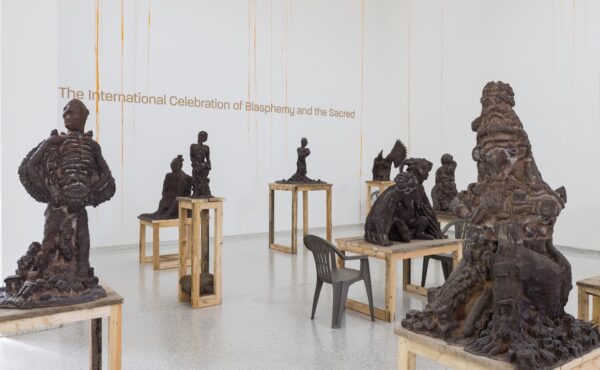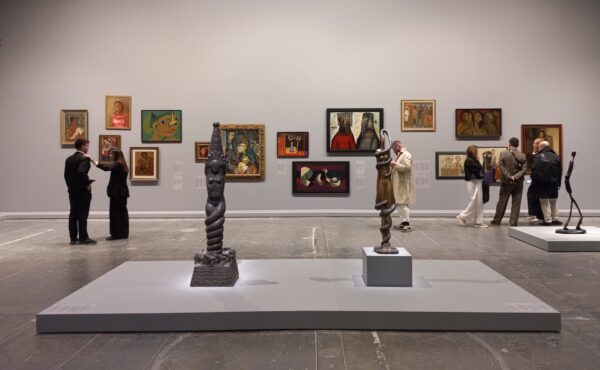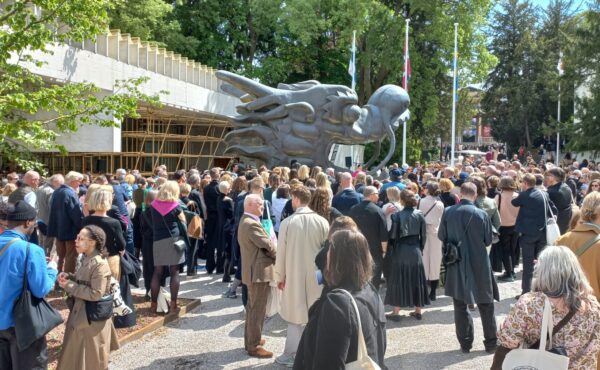
Empowerment, Will, and Wit – Venice Biennale Pavilions (Part 2)
From Lebanon’s woven, feminist rethinkings of Greek mythology to the Ukrainian Pavilion’s resilience in the face of conflict: Katia Krupennikova offers an overview of the 60th Venice Biennial’s most noteworthy national pavilions.
Egypt – Wael Shawky
One of the most memorable exhibitions during the 60th Venice Biennale is Wael Shawky’s Drama 1882 at the Egyptian pavilion. As the title suggests, Drama 1882 zooms in on the year 1882 and the nationalist Urabi revolution, whose brutal defeat established British occupation of Egypt until 1956. Visually recognizable and internationally acclaimed, Shawki’s work frequently delves into complex historical events and narratives, offering critical reflections on turning points in the history of the Middle East. Notably, for this work, for the first time in his rich oeuvre Shawki does not use puppets as agents of his narration, but collaborates with actors who sing opera of this painful moment in Egyptian history in ancient Arabic language. Contrasting colors, slow motion, and exaggerated, absurd postures and movements of the actors imbue the film with a nightmarish quality that leaves no one indifferent and thus urges to question the histories written by the winners. Along with the film, the exhibition features a variety of media on display: vitrines, sculptures, paintings, drawings, and a mirror relief.
Lebanon – Mounira Al Solh
The Lebanese Pavilion, represented by Netherlands-based artist Mounira al Solh who is known for her research into collective memory, particularly within the context of the Middle East and its diaspora communities. Mounira’s work method blends history with metaphor, playfulness with urgency, politics with poetry, communal narratives with personal and intimate experiences. Choreographed as an ongoing boat journey, the scenography, designed by architect Karim Bekdacheit, skilfully guides viewers through a modern feminist reinterpretation of the abduction of Phoenician princess Europe, woven from a perspective of a modern feminist, filtered through artist’s own critical eyes and experiences. In al Solh’s work myths are deconstructed and reconstructed into a feminist iconography, tackling themes of gender equality and the female struggle for agency in narrative-making. Using drawings, banners, masks, moving images, and a rich palette of colors from Mediterranean region, along with mythological and historical references—primarily from Phoenician times—Mounira al Solh deftly intertwines pressing questions of the past, present, and future.
Finland – Pia Lindman, Vidha Saumya, Jenni-Juulia Wallinheimo-Heimonen
The Finnish Pavilion is worth mentioning not merely for its noteworthy art, but also for propagating an inclusive gesture into the 60th Venice Biennale. Featuring artists Pia Lindman, Vidha Saumya, Jenni-Juulia Wallinheimo-Heimonen, in deep dialogue with curators Yvonne Billimore, Jussi Koitela, and architectural designer Kaisa Sööt, this exhibition marks a historic milestone at the Venice Biennale. It centres on differently abled artists, illuminating the intricate fusion of their life experiences and artistic endeavours. In Venice, where accessibility remains a challenge with only fifty percent of its spaces accommodating wheelchairs and in Giardini, where gravel does not allow a wheelchair to move smoothly, conveners converge to present a profound discourse on accessibility. They embark on a journey of reimagining spaces, entering a conversation with architectural researcher, Jos Boys, who speaks of “occupancies” — the intricate web of relationships between people, buildings, objects, and spaces.
Artist and healer, Lindman, confronted with mercury poisoning, channels her heightened sensitivity into her artistic expression. Her creations, whether in images, sounds, words, or colours, serve as poignant reflections of her embodied experiences. As part of her Collectivities Cycle, Lindman presents a meticulously crafted air-conditioning clay sculpture. This creation invites the public to engage with the air, permeated by microorganisms that transform its essence and filter out pollution. Saumya’s textile compositions titled to all the barricades… the rumour got you come, weave a narrative of interconnectedness between economic structures and spatial organisation.
Through these textile works, Saumya unveils the pervasive contamination of everyday life by these forces. Artist and disability activist, Wallinheimo-Heimonen, employs moving sculptures and a series of short films titled How Great Is Your Darkness to confront the issue of hate speech commonly targeting individuals with disabilities, particularly from medical professionals. Her work serves as a potent rebuttal and an statement to the prevailing narratives of shame, deficiency, and inferiority imposed upon differently abled individuals. The installation is specifically designed to offer optimal viewing positions for wheelchair users and the architectural structure designed by Sööt gives a practical hint to what the meaning of access architecture could be. Along with the tactile map for visually impaired people, it underscores the commitment to accessibility woven into the fabric of the exhibition.
Ukraine – four artists/collectives
The Ukrainian pavilion struck me as a sincere reflection of the strong character of Ukrainian society. Titled Net Making and curated by Viktoria Bavykina and Max Gorbatskyi, it features four artists/collectives and reflects on practices of Ukrainian self-organization and mutual support in the face of Russian invasion. The atmosphere of the pavilion is very warm and homely, constructed with wood and textile walls made by artist Oleksandr Burlaka enclosing the pavilion. Fashioned from linen dating back to the 50s and 60s evoking traditional homemade fabric, sourced from flea markets in Ukraine, the wall connects four interwoven artworks.
Andrii Rachynskyi and Daniil Revkovskyi have created a montage of fragments from social media documenting the full-scale Russian invasion of Ukraine, spanning from its onset to the present moment. Beginning with the realization of war, the footage sourced from the social media accounts of ordinary Ukrainian citizens gradually shifts to depict various hostilities and instances of marauder behavior.
A video installation by Andrii Dostliev and Lia Dostlieva highlights the problematic stereotypic framing of Ukrainian refugees in the West and the expectations imposed on them by their Western hosts. A collective project by Katya Buchatska in collaboration with neurodiverse artists Anastasia Averina, Chef Georgy, Iryna Holoborod’ko, and many others who were participating in daily online inclusive art sessions, fostering mutual support and attempting to stick to daily routines to counter the dread of war. The exhibition is full of empowerment, will, and wit. It is imbued with a unique sense of humor authentic to the Ukrainian spirit.
Uzbekistan – Aziza Kadyri and the Qizlar (Uzbek) Collective
The Uzbekistan Pavilion made its second appearance at the Venice Biennale, this time curated by the Tashkent Center for Contemporary Art. Titled Don’t Miss the Cue, the pavilion showcased the collaborative efforts of artist Aziza Kadyri and the Tashkent-based female artist group, Qizlar (Uzbek) Collective. Centered around the concept of transforming female identity collectivity within changing Uzbek society, amplifying female voices through reference to the laborious craft and collective practices of traditional Uzbek embroidery, known as ‘suzani’, the pavilion delved into ancient customs where girls, supported by their female community, would meticulously craft their own dowry. Kadyri ingeniously incorporated recognizable suzani patterns into her work, leveraging artificial intelligence to explore the intersection of labor, technology, and tradition—a compelling juxtaposition that prompts deeper reflection.
The pavilion, to my taste, veered too far into theatricality, relying heavily on dramatic lighting and a labyrinthine layout. This approach, featuring video footage and textiles, ultimately led the audience to a cathartic backstage scene reminiscent of a theatre or a Soviet-era House of Culture. While the intention behind the deliberate layout was apparent, at times it felt overly contrived. Nevertheless, the pavilion strongly succeeded in creating an immersive experience and finding a nuanced interplay between tradition, technology, and community.
Croatia –
The Croatian pavilion, nestled away from the usual paths of Venice, proved to be a gem worth seeking out. Conceived by artist Vlatka Horvat and curated by Antonia Majaca, both based outside Croatia, the project titled Means at Hand, beautifully captured the intricate networks and informal economies fostered by the global diaspora. Under Horvat’s invitation, a diverse array of artists from around the world, such as Jasmina Cibic (UK/Croatia), Lia Dostlieva (Ukraine/Poland), Ahmet Öğüt (Turkey/Germany/The Netherlands), Arseny Zhilyaev (Russia/Italy), ingeniously circumvented traditional channels to present their works within the pavilion. This collaborative effort resulted in at times unimaginable constellation of artworks and names, forging unexpected connections across borders and transforming a conservative, national pavilion into an international one.
In a unique exchange, upon the arrival of each artwork, Vlatka Horvat committed to crafting a piece of her own to be sent back to the contributing artist, with the stipulation that it be exhibited in a semi-public space, such as visible through a window. This reciprocal gesture added a layer of intimacy and exchange to the project, blurring the lines between creator and curator. Every facet of the art handling process was meticulously documented and showcased within the pavilion, alongside a rotating selection of daily featured artworks. Horvat, immersing herself in the project, took up residence within the pavilion, diligently curating new compilations of works while also creating her own pieces, all the while ensuring the smooth operation of logistics. The pavilion itself resembled a hybrid of a post office, a domestic dwelling, a museum’s registrar office, and an exhibition space, embodying the multifaceted nature of artistic expression and curation. As a member of the diaspora, this project stirred a plethora of emotions, touching on themes of identity, politics, borders, wars, familial ties, and the enduring bonds of friendship—evoking the poignant experience of sending something to distant family or friends via a stranger and receiving something in return.
Estonia – Edith Karlson
A picturesque walk from the Croatian pavilion to the even further situated Estonian Pavilion leads me through Venetian residential neighborhoods, filled with trees, scents of flowers, and tranquility. Continuing this aesthetic journey, Estonian artist Edith Karlson’s atmospheric total installation, Hora Lupi (hour of the wolf), inhabited the 18th-century church of Chiesa di Santa Maria delle Penitenti with magical creatures and objects, such as giants, mermaids, double-headed cats, weeping virgins, bird skulls, palettes, and anthropomorphic candles. Twilight, known as the ‘hour of the wolf’, or the ‘crack between the worlds’ is often described as a mystical when the visible world and the invisible, life and death, merge into each other. Much like this metaphor, Karlson’s works connect, clench, and embed themselves into the architecture, blending with its dust, scents, and cracks. The figures created by the artist appear as mythical creatures, but their faces actually belong to individuals from the artist’s circle: children and elderly people, state officials, and common workers who have made self-portraits. Through Hora Lupi, situated in Venetian sacral architecture, the artist references the site and context of a 14th-century St. John’s Church in Tartu, Estonia, where terracotta sculptures might embody people who lived then, just like the artists’ protagonists today, and whose sculptured faces became their memorial.
Katia Krupennikova
is curator en schrijver


















































